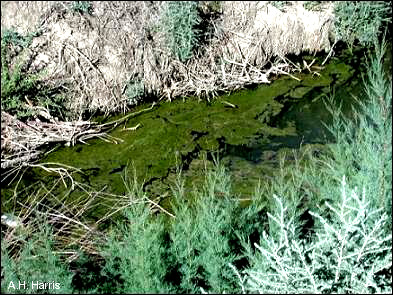

Remember the old game of 20 questions? You had to figure out what your opponent had in mind by asking yes or no questions, but you started out being told whether the subject was animal, mineral, or vegetable.
Well, with advances in biological knowledge, the plant or animal part doesn't do it any more. Today, many biologists recognize six kingdoms of living things: bacteria, archaebacteria, protists, fungi, plants, and animals. Much of this revolution has come about as we increased our knowledge of the internal structure of the cells that make up organisms.
In our Chihuahuan Desert, all six kingdoms are well represented. Most
people recognize plants and animals, and many understand that toadstools are fungi.
Protists? Think of the algae plentiful in many desert pools. Find a hot spring, and the
chances are good that archaebacteria are enjoying a temperature that would roast most
living things. For bacteria, almost any place will do—one reason antibacterial soaps
are so popular. Paleontologists like to call the present the Age of Mammals, but for
over 3.5 billion years, this really has been the Age of Bacteria.

Listen to the Audio (mp3 format) as recorded by KTEP, Public Radio for the Southwest.
Contributor: Arthur H. Harris, Laboratory for Environmental Biology, Centennial Museum, University of Texas at El Paso.
Desert Diary is a joint production of the Centennial Museum and KTEP National Public Radio, University of Texas at El Paso.

Two of the six kingdoms: Plants and Protists. Drainage ditch in the Rio Grande Valley in Socorro, TX, with algae forming a scum on the stagnant water and young tamarisk, chenopod, and wolfberry plants near the water's edge. Photograph by A.H. Harris.
Starr, C., and R. Taggart. 1998. Biology. The unity and diversity of
life. 8th ed., Wadsworth Publishing Co., Belmont, CA, 920 pp. ![]()